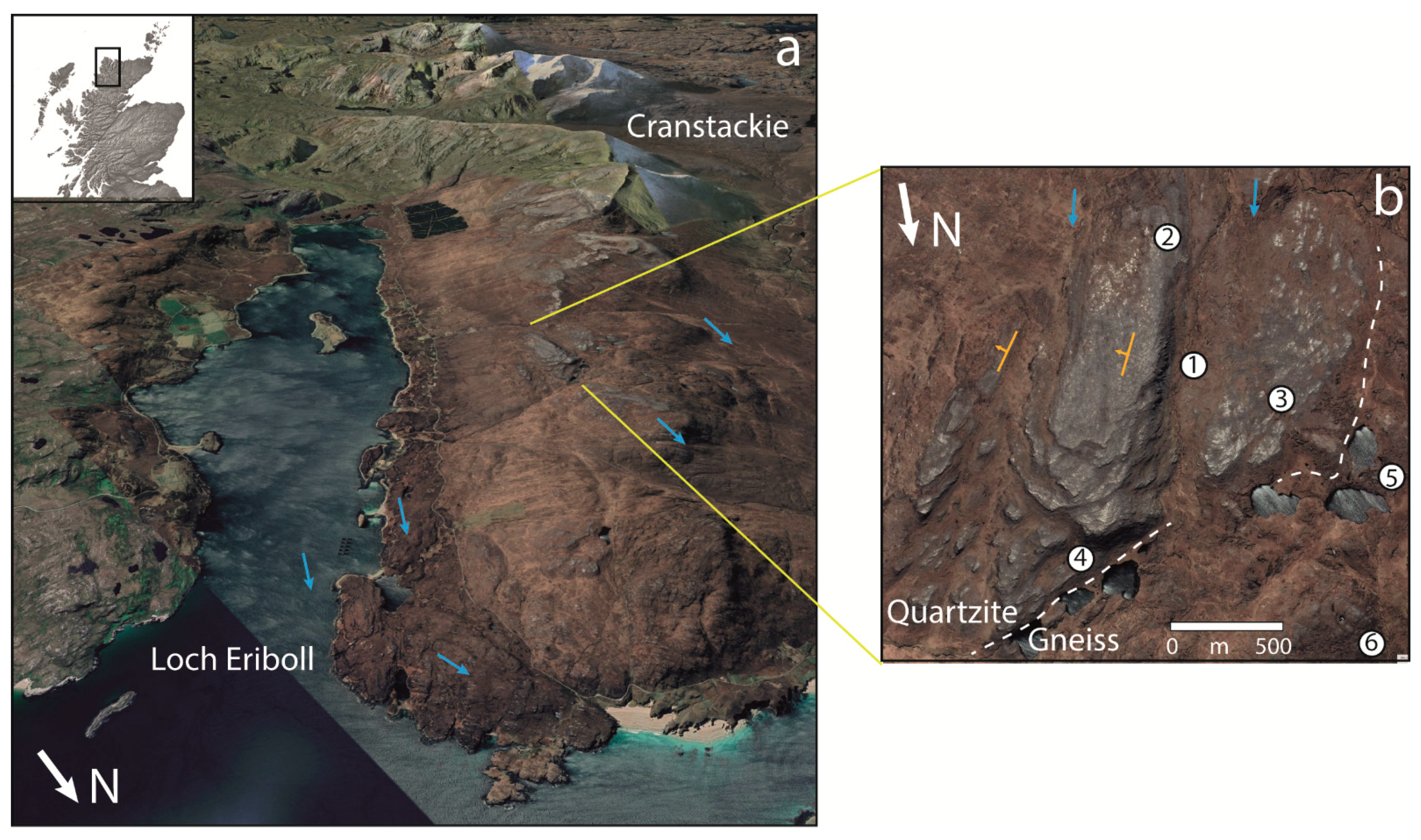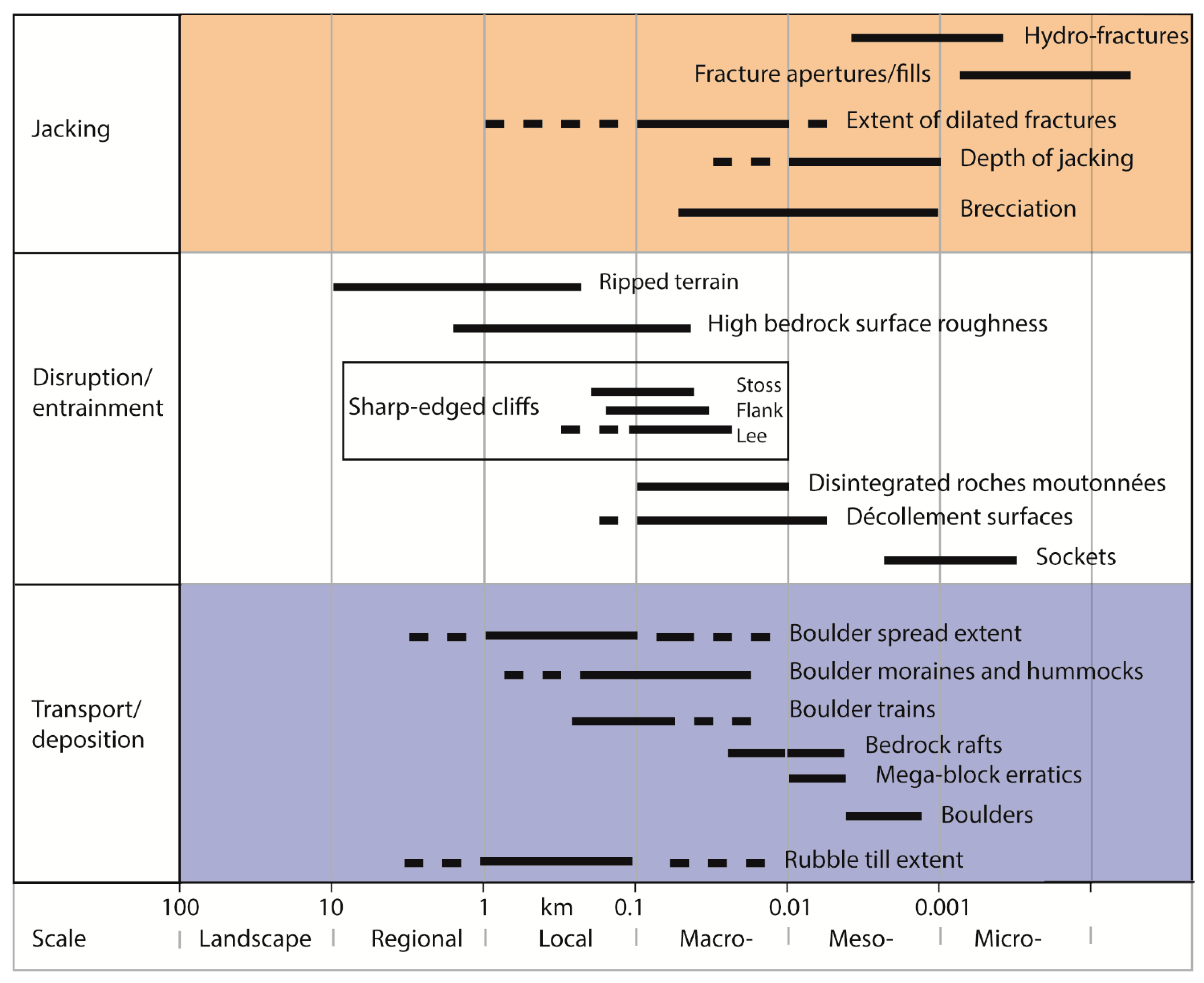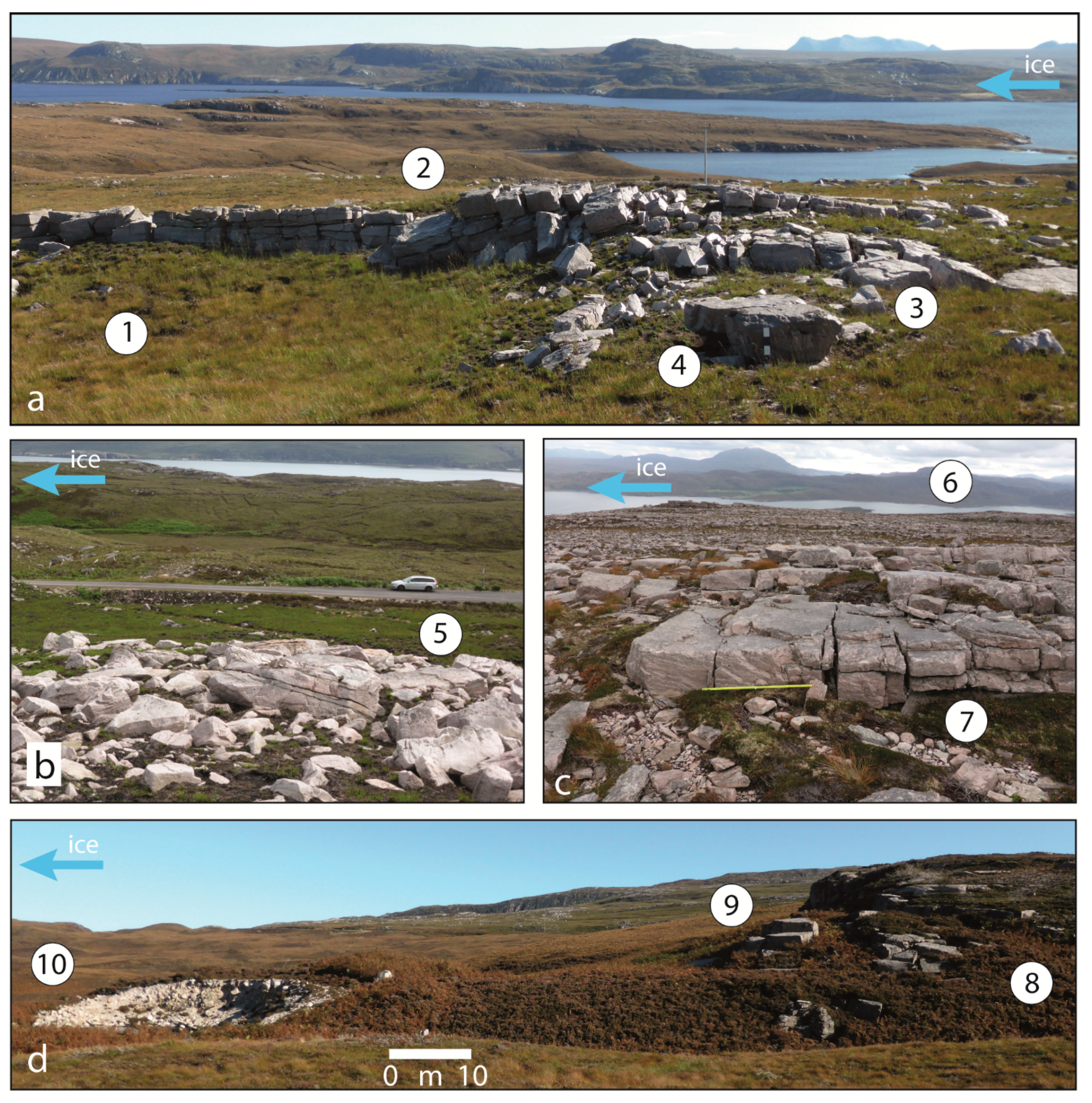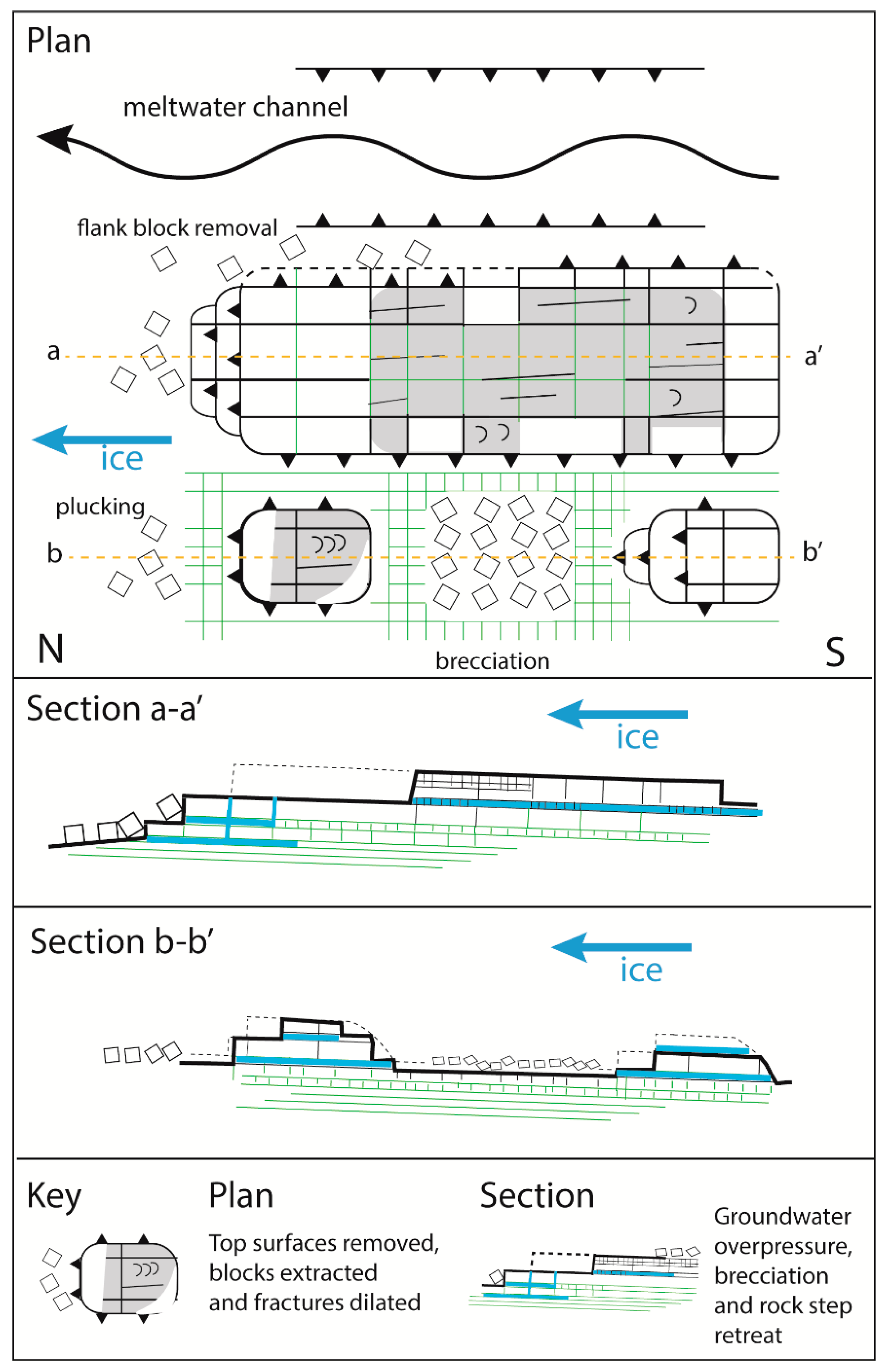Glacial Ripping in Sedimentary Rocks: Loch Eriboll, NW Scotland
Abstract
:1. Introduction
2. Geology and Glacial Geomorphology
2.1. Geology
2.2. Ice Dynamics
3. Methods
4. Results
4.1. Precursor Glacial Forms
4.2. Fracture Dilation and Formation
4.3. Disruption of Rock Surfaces
4.4. Block Removal
4.5. Block Transport
4.6. Breccias, Boulder Spreads, Rubble Tills, and Moraines
4.7. Summary of Damage to Precursor Glacial Forms: Evidence for Glacial Ripping
5. Discussion
5.1. Hydraulic Jacking and Brecciation in Response to Subglacial Groundwater Overpressure
5.2. Movement and Transport
5.3. Importance of Structural Controls
5.4. Timing of Glacial Ripping at Loch Eriboll
5.5. Glaciological Conditions for Glacial Ripping at Loch Eriboll
5.6. Erosional Impact of Glacial Ripping
5.7. Glacial Ripping and Rubble Till Formation in Other Sedimentary Rocks
6. Conclusions
Author Contributions
Funding
Institutional Review Board Statement
Informed Consent Statement
Data Availability Statement
Acknowledgments
Conflicts of Interest
References
- Hall, A.M.; Krabbendam, M.; van Boeckel, M.; Goodfellow, B.W.; Hättestrand, C.; Heyman, J.; Palamakumbura, R.N.; Stroeven, A.P.; Näslund, J.-O. Glacial ripping: Geomorphological evidence from Sweden for a new process of glacial erosion. Geogr. Ann. Ser. A Phys. Geogr. 2020, 102, 333–353. [Google Scholar] [CrossRef]
- Krabbendam, M.; Arnhardt, C.; Palamakumbura, R.; Hall, A.M. Rock fracturing by subglacial hydraulic jacking in basement rocks, eastern Sweden: The role of beam failure. GFF 2021. accepteded. [Google Scholar]
- Park, R.G.; Stewart, A.D.; Wright, D.T. The Hebridean terrane. In The Geology of Scotland; Trewin, N.H., Ed.; The Geological Society London: London, UK, 2002; pp. 45–61. [Google Scholar]
- Swett, K.; Klein, G.D.; Smit, D.E. A Cambrian tidal sand body: The Eriboll Sandstone of Northwest Scotland: An ancient-recent analog. J. Geol. 1971, 79, 400–415. [Google Scholar] [CrossRef]
- Laubach, S.; Diaz-Tushman, K. Laurentian palaeostress trajectories and ephemeral fracture permeability, Cambrian Eriboll Formation sandstones west of the Moine Thrust Zone, NW Scotland. J. Geol. Soc. 2009, 166, 349–362. [Google Scholar] [CrossRef]
- McKie, T. Barrier island to tidal shelf transition in the early Cambrian Eriboll Sandstone. Scott. J. Geol. 1989, 25, 273–293. [Google Scholar] [CrossRef]
- Krabbendam, M.; Glasser, N.F. Glacial erosion and bedrock properties in NW Scotland: Abrasion and plucking, hardness and joint spacing. Geomorphology 2011, 130, 374–383. [Google Scholar] [CrossRef] [Green Version]
- Krabbendam, M.; Bradwell, T. Lateral plucking as a mechanism for elongate erosional glacial bedforms: Explaining megagrooves in Britain and Canada. Earth Surf. Process. Landf. 2011, 36, 1335–1349. [Google Scholar] [CrossRef] [Green Version]
- Hooker, J.; Laubach, S.; Gomez, L.; Marrett, R.; Eichhubl, P.; Diaz-Tushman, K.; Pinzon, E. Fracture size, frequency, and strain in the Cambrian Eriboll Formation sandstones, NW Scotland. Scott. J. Geol. 2011, 47, 45–56. [Google Scholar] [CrossRef]
- Bradwell, T.; Stoker, M.S.; Larter, R. Geomorphological signature and flow dynamics of The Minch palaeo-ice stream, northwest Scotland. J. Quat. Sci. 2007, 22, 609–617. [Google Scholar] [CrossRef] [Green Version]
- Everest, J.; Bradwell, T.; Stoker, M.; Dewey, S. New age constraints for the maximum extent of the last British–Irish Ice Sheet (NW sector). J. Quat. Sci. 2013, 28, 2–7. [Google Scholar] [CrossRef] [Green Version]
- Mathers, H. The Impact of the Minch Palaeo-Ice Stream in NW Scotland: Constraining Glacial Erosion and Landscape Evolution through Geomorphology and Cosmogenic Nuclide Analysis. Ph.D. Thesis, University of Glasgow, Scotland, UK, 2014. [Google Scholar]
- Hall, A.M.; Ebert, K.; Goodfellow, B.W.; Hättestrand, C.; Heyman, J.; Krabbendam, M.; Moon, S.; Stroeven, A.P. Past and Future Impact of Glacial Erosion in Forsmark and Uppland; Svensk Kärnbränslehantering AB: Stockholm, Sweden, 2019; p. 247. [Google Scholar]
- Terry, J.; Goff, J. Megaclasts: Proposed revised nomenclature at the coarse end of the Udden-Wentworth grain-size scale for sedimentary particles. J. Sediment. Res. 2014, 84, 192–197. [Google Scholar] [CrossRef]
- Finch, T.; Synge, F. The drifts and soils of West Clare and the adjoining parts of counties Kerry and Limerick. Ir. Geogr. 1965, 5, 161–172. [Google Scholar] [CrossRef]
- Hall, A.M.; Whittington, G. Late Devensian glaciation of southern Caithness. Scott. J. Geol. 1989, 25, 307–324. [Google Scholar] [CrossRef]
- Morrow, D.W. Descriptive field classification of sedimentary and diagenetic breccia fabrics in carbonate rocks. Bull. Can. Pet. Geol. 1982, 30, 227–229. [Google Scholar]
- Woodcock, N.H.; Miller, A.V.M.; Woodhouse, C.D. Chaotic breccia zones on the Pembroke Peninsula, south Wales: Evidence for collapse into voids along dilational faults. J. Struct. Geol. 2014, 69, 91–107. [Google Scholar] [CrossRef] [Green Version]
- Krüger, J.; Kjær, K.H. A data chart for field description and genetic interpretation of glacial diamicts and associated sediments…with examples from Greenland, Iceland, and Denmark. Boreas 1999, 28, 386–402. [Google Scholar] [CrossRef]
- Lawson, T.J. Glacial striae and former ice movement: The evidence from Assynt, Sutherland. Scott. J. Geol. 1996, 32, 59–65. [Google Scholar] [CrossRef]
- Krabbendam, M.; Bradwell, T.; Everest, J.D.; Eyles, N. Joint-bounded crescentic scars formed by subglacial clast-bed contact forces: Implications for bedrock failure beneath glaciers. Geomorphology 2017, 290, 114–127. [Google Scholar] [CrossRef] [Green Version]
- Ravier, E.; Buoncristiani, J.-F.; Menzies, J.; Guiraud, M.; Portier, E. Clastic injection dynamics during ice front oscillations: A case example from Sólheimajökull (Iceland). Sediment. Geol. 2015, 323, 92–109. [Google Scholar] [CrossRef]
- Mccarroll, D.; Ballantyne, C.K.; Nesje, A.; Dahl, S.O. Nunataks of the last ice sheet in northwest Scotland. Boreas 1995, 24, 305–323. [Google Scholar] [CrossRef]
- Lesemann, J.-E.; Alsop, G.I.; Piotrowski, J.A. Incremental subglacial meltwater sediment deposition and deformation associated with repeated ice-bed decoupling: A case study from the Island of Funen, Denmark. Quat. Sci. Rev. 2010, 29, 3212–3229. [Google Scholar] [CrossRef]
- Rothlisberger, H.; Iken, A. Plucking as an effect of water-pressure variations at the glacier bed. Ann. Glaciol. 1981, 2, 57–62. [Google Scholar] [CrossRef] [Green Version]
- Harper, J.T.; Humphrey, N.F.; Pfeffer, W.T.; Lazar, B. Two modes of accelerated glacier sliding related to water. Geophys. Res. Lett. 2007, 34. [Google Scholar] [CrossRef] [Green Version]
- Yeo, I.; De Freitas, M.; Zimmerman, R. Effect of shear displacement on the aperture and permeability of a rock fracture. Int. J. Rock Mech. Min. Sci. 1998, 35, 1051–1070. [Google Scholar] [CrossRef]
- Boulton, G.S.; Hagdorn, M. Glaciology of the British Isles Ice Sheet during the last glacial cycle: Form, flow, streams and lobes. Quat. Sci. Rev. 2006, 25, 3359–3390. [Google Scholar] [CrossRef]
- Boulton, G.S.; Caban, P. Groundwater flow beneath ice sheets: Part II—its impact on glacier tectonic structures and moraine formation. Quat. Sci. Rev. 1995, 14, 563–587. [Google Scholar] [CrossRef]
- Alley, R.; Cuffey, K.; Zoet, L. Glacial erosion: Status and outlook. Ann. Glaciol. 2019, 60, 1–13. [Google Scholar] [CrossRef] [Green Version]
- Glasser, N.F.; Roman, M.; Holt, T.O.; Žebre, M.; Patton, H.; Hubbard, A.L. Modification of bedrock surfaces by glacial abrasion and quarrying: Evidence from North Wales. Geomorphology 2020, 365, 107283. [Google Scholar] [CrossRef]
- Hallet, B. Glacial abrasion and sliding: Their dependence on the debris concentration in basal ice. Ann. Glaciol. 1981, 2, 23–28. [Google Scholar] [CrossRef] [Green Version]
- Migoń, P. Sandstone geomorphology–recent advances. Geomorphology 2020, 373, 107484. [Google Scholar] [CrossRef]
- Merritt, J.W.; Coope, G.R.; Taylor, B.J.; Walker, M.J.C. Late Devensian organic deposits beneath till in the Teith Valley, Perthshire. Scott. J. Geol. 1990, 26, 15–24. [Google Scholar] [CrossRef]
- Evans, D.J.; Dinnage, M.; Roberts, D.H. Glacial geomorphology of Teesdale, northern Pennines, England: Implications for upland styles of ice stream operation and deglaciation in the British-Irish Ice Sheet. Proc. Geol. Assoc. 2018, 129, 697–735. [Google Scholar] [CrossRef] [Green Version]
- Harris, C. Glacially deformed bedrock at Wylfa Head, Anglesey, North Wales. In Engineering Geology Special Publications; Geological Society: London, UK, 1991; Volume 7, pp. 135–142. [Google Scholar] [CrossRef]
- Evans, D.J.A.; Rea, B.R.; Benn, D.I. Subglacial deformation and bedrock plucking in areas of hard bedrock. Glacial Geol. Geomorphol. 1998, 1, 1–25. [Google Scholar]
- Phillips, E.; Everest, J.; Reeves, H. Micromorphological evidence for subglacial multiphase sedimentation and deformation during overpressurized fluid flow associated with hydrofracturing. Boreas 2013, 42, 395–427. [Google Scholar] [CrossRef] [Green Version]
- Phillips, E.; Auton, C. Microtextural analysis of a glacially ‘deformed’ bedrock: Implications for inheritance of preferred clast orientations in diamictons. J. Quat. Sci. 2008, 23, 229–240. [Google Scholar] [CrossRef]
- Croot, D.G.; Sims, P.C. Early stages of till genesis: An example from Fanore, County Clare, Ireland. Boreas 1996, 25, 37–46. [Google Scholar] [CrossRef]
- Hiemstra, J.F.; Evans, D.J.A.; Cofaigh, C.Ó. The role of glacitectonic rafting and comminution in the production of subglacial tills: Examples from southwest Ireland and Antarctica. Boreas 2007, 36, 386–399. [Google Scholar] [CrossRef]
- Vaughan-Hirsch, D. Large-scale thrusting and glacitectonic rafting of limestone bedrock during active ice retreat: An example from Killala Bay, Co. Mayo, Republic of Ireland. Quat. Int. 2012, 279–280, 516. [Google Scholar] [CrossRef]
- Phillips, E.; Lee, J.R.; Riding, J.B.; Kendall, R.; Hughes, L. Periglacial disruption and subsequent glacitectonic deformation of bedrock: An example from Anglesey, North Wales, UK. Proc. Geol. Assoc. 2013, 124, 802–817. [Google Scholar] [CrossRef] [Green Version]
- Davies, B.J.; Roberts, D.H.; Ó Cofaigh, C.; Bridgland, D.R.; Riding, J.B.; Phillips, E.R.; Teasdale, D.A. Interlobate ice-sheet dynamics during the last glacial maximum at Whitburn Bay, County Durham, England. Boreas 2009, 38, 555–578. [Google Scholar] [CrossRef] [Green Version]
- Różycki, S.Z.; Lamparski, Z. Exaration phenomena at the terminal icesheet parts of the Middle-Polish Glaciation along the northern slopes of the Central Polish Uplands. Acta Geol. Pol. 1982, 32, 207–216. [Google Scholar]
- Eyles, N.; Doughty, M. Glacially-streamlined hard and soft beds of the paleo-Ontario ice stream in Southern Ontario and New York state. Sediment. Geol. 2016, 338, 51–71. [Google Scholar] [CrossRef]
- Schroeder, J.; Beaupré, M.; Cloutier, M. Ice-push caves in platform limestones of the Montréal area. Can. J. Earth Sci. 1986, 23, 1842–1851. [Google Scholar] [CrossRef]
- Schroeder, J.; Beaupré, M.; Caron, D. Glacitectonic caves in the St. Lawrence lowlands of Québec. In Landscapes and Landforms of Eastern Canada; Springer: Berlin, Germany, 2020; pp. 509–523. [Google Scholar]
- Broughton, P.L. Subglacial blowouts in western Canada: Insights into extreme meltwater pressures and hydrofracturing. Boreas 2018, 47, 326–346. [Google Scholar] [CrossRef] [Green Version]
- Broster, B.; Dreimanis, A.; White, J. A sequence of glacial deformation, erosion, and deposition at the ice–rock interface during the last glaciation: Cranbrook, British Columbia, Canada. J. Glaciol. 1979, 23, 283–295. [Google Scholar] [CrossRef]
- Aber, J.S.; Croot, D.G.; Fenton, M.M. Hill-Hole Pair. In Glaciotectonic Landforms and Structures; Springer: Berlin/Heidelberg, Germany, 1989; pp. 13–28. [Google Scholar]
- Evans, D.J.A.; Phillips, E.R.; Hiemstra, J.F.; Auton, C.A. Subglacial till: Formation, sedimentary characteristics and classification. Earth-Sci. Rev. 2006, 78, 115–176. [Google Scholar] [CrossRef] [Green Version]
- Lee, J.R.; Phillips, E. Glacitectonics–A key approach to examining ice dynamics, substrate rheology and ice-bed coupling. Proc. Geol. Assoc. 2013, 124, 731–737. [Google Scholar] [CrossRef] [Green Version]
- Phillips, E.R. Chapter 13—Glacitectonics. In Past Glacial Environments, 2nd ed.; Menzies, J., van der Meer, J.J.M., Eds.; Elsevier: Amsterdam, The Netherlands, 2018; pp. 467–502. [Google Scholar] [CrossRef]
- Knight, J. Glacitectonic sedimentary and hydraulic processes at an oscillating ice margin. Proc. Geol. Assoc. 2012, 123, 714–727. [Google Scholar] [CrossRef]
- Sigfúsdóttir, T.; Phillips, E.; Benediktsson, Í.Ö. Micromorphological evidence for the role of pressurised water in the formation of large-scale thrust-block moraines in Melasveit, western Iceland. Quat. Res. 2020, 93, 88–109. [Google Scholar] [CrossRef] [Green Version]
- Phillips, E.; Lee, J.R. Development of a subglacial drainage system and its effect on glacitectonism within the polydeformed Middle Pleistocene (Anglian) glacigenic sequence of north Norfolk, Eastern England. Proc. Geol. Assoc. 2013, 124, 855–875. [Google Scholar] [CrossRef] [Green Version]
- Warbritton, M.; Iverson, N.R.; Lagroix, F.; Schomacker, A. Strain patterns in glacitectonically thrusted sediments and conditions during thrusting. J. Struct. Geol. 2020, 137, 104064. [Google Scholar] [CrossRef]
- Aber, J.; Lundqvist, J. Glaciotectonic structures in central Sweden and their significance for glacial theory. Géographie Phys. Quat. 1988, 42, 315–323. [Google Scholar] [CrossRef] [Green Version]
- Rattas, M.; Kalm, V. Glaciotectonic deformation patterns in Estonia. Geol. Q. 2004, 48, 15–22. [Google Scholar]
- Hall, A.M.; van Boeckel, M. Origin of the Baltic Sea basin by Pleistocene glacial erosion. GFF 2020, 142, 237–252. [Google Scholar] [CrossRef]
- Larson, G.; Schaetzl, R. Origin and evolution of the Great Lakes. J. Great Lakes Res. 2001, 27, 518–546. [Google Scholar] [CrossRef]
- Shulmeister, J. A conceptual model for the deposition of the Dummer Moraine, Southern Ontario. Geomorphology 1989, 2, 385–392. [Google Scholar] [CrossRef]
- Bukhari, S.; Eyles, N.; Sookhan, S.; Mulligan, R.; Paulen, R.; Krabbendam, M.; Putkinen, N. Regional subglacial quarrying and abrasion below hard-bedded palaeo-ice streams crossing the Shield–Palaeozoic boundary of central Canada: The importance of substrate control. Boreas 2021. [Google Scholar] [CrossRef]














| Process Step | Criterion | Feature | Definition | Additional References |
|---|---|---|---|---|
| Jacking | J1 | Dilated fracture | Existing rock fracture opened under groundwater at overpressure | |
| J2 | Brecciation | Disintegration of the near-surface rock mass into angular fragments with little or no transport | ||
| J3 | Hydro-fracture | New fracture formed under groundwater overpressure | ||
| J4 | Beam failure fracture | New vertical fracture formed as rock beams crack whilst jacked under ice loading | [2] | |
| J5 | Fracture fill | Clastic dykes and sills filling dilated fractures | ||
| Disruption | D1 | Ripped terrain | Rock terrain showing high rock surface roughness, displaced blocks, and angular rock forms | [13] |
| D2 | Cliff | Sites of tearaway where rock sheets or blocks were lost from the stoss, flank and lee sides of rock hills | ||
| D3 | Décollement surface | Basal failure plane beneath mobilised or missing rock sheets | ||
| D4 | Disintegrated roches moutonnées | Roches moutonnées opened up under subglacial traction | ||
| D5 | Fracture cave | Fracture-bounded cave developed from pull-apart of the rock mass | ||
| D6 | Socket | Site of rock block removal by moving glacier ice | [13] | |
| Transport and deposition | T1 | Boulder spread | Dense surface concentration of angular, locally derived, and glacially transported boulders | |
| T2 | Boulder moraine | Ridge or hummock composed largely of angular boulders and set within boulder spreads | ||
| T3 | Bedrock raft | A largely intact mass of bedrock moved by ice from its original position | ||
| T4 | Boulder train | A swath or trail of boulders found down-ice of the source outcrop | ||
| T5 | Megaclast erratic | Rock block with b axis > 4.1 m | [14] | |
| T6 | Rubble till | Immature, poorly sorted subglacial deposit showing high clast angularity and low matrix fines content, dominated by clasts of local bedrock (monomict) | [15,16] |
| Ice Sheet | Location | Rock Types | Criteria | Reference(s) |
|---|---|---|---|---|
| BIIS | Loch Eriboll, Scotland | Cambrian quartz-arenite | J1, J2, J4, J5, D1–D4, D6, T1–T4, T6 | This paper |
| Loch Quoich, Scotland | Moine psammite (meta-sandstone) | J1–J3, J5, T6 | [37] | |
| Meads of St John, Scotland | Devonian sandstone | J1–J3, J5, T3 | [38] | |
| North Corbelly, Dumfries, Scotland | Weakly-metamorphosed Palaeozoic sandstones, mudstones | J2, J3, T6 | [39] | |
| Fanore, County Clare, Ireland | Carboniferous limestone | J1–J3, J4?,J5, D2, D3, T1, T3, T5, T6 | [40] | |
| Clogher Bay, Dingle Peninsula, Ireland | Palaeozoic sandstone, limestone, mudstone | J1–J3, J5, T3, T5, T6 | [41] | |
| Killala Bay, Mayo, Ireland | Carboniferous limestone | J2, D3, D4, T3, T5, T6 | [42] | |
| Anglesey, Wales | Cambrian meta-sandstones and mudstones | J1–J3, J5, D3, T3, T5, T6 | [43] | |
| Teesdale, England | Carboniferous sandstone, limestone | J1–J2, D1, D3, T3, T6 | [35] | |
| Whitburn Bay, Durham. England | Permian limestone | J1–J3, J5, T6 | [44] | |
| FIS | Częstochowa, Poland | Cretaceous marl, Jurassic limestone | J2, D3, T3, T6 | [45] |
| LIS | Dummer moraine, Ontario, Canada | Ordovician limestone | J1–J3, J4?, D1–D3, T1–T6 | [46] |
| Montréal city, Canada | J1, J2, J4?, D2, D3. D5, T3 | [47,48] | ||
| Muskeg River, Alberta, Canada | Cretaceous sandstone | J1–J3, J5, T6 | [49] | |
| CoIS | Cranbrook, British Columbia | Proterozoic quartzite | J1–J3, J5, D3, T3, T6 | [50] |
Publisher’s Note: MDPI stays neutral with regard to jurisdictional claims in published maps and institutional affiliations. |
© 2021 by the authors. Licensee MDPI, Basel, Switzerland. This article is an open access article distributed under the terms and conditions of the Creative Commons Attribution (CC BY) license (https://creativecommons.org/licenses/by/4.0/).
Share and Cite
Hall, A.M.; Mathers, H.; Krabbendam, M. Glacial Ripping in Sedimentary Rocks: Loch Eriboll, NW Scotland. Geosciences 2021, 11, 232. https://doi.org/10.3390/geosciences11060232
Hall AM, Mathers H, Krabbendam M. Glacial Ripping in Sedimentary Rocks: Loch Eriboll, NW Scotland. Geosciences. 2021; 11(6):232. https://doi.org/10.3390/geosciences11060232
Chicago/Turabian StyleHall, Adrian M., Hannah Mathers, and Maarten Krabbendam. 2021. "Glacial Ripping in Sedimentary Rocks: Loch Eriboll, NW Scotland" Geosciences 11, no. 6: 232. https://doi.org/10.3390/geosciences11060232






